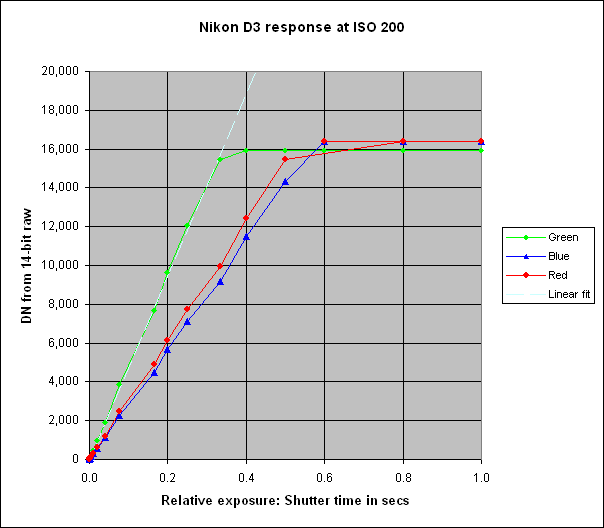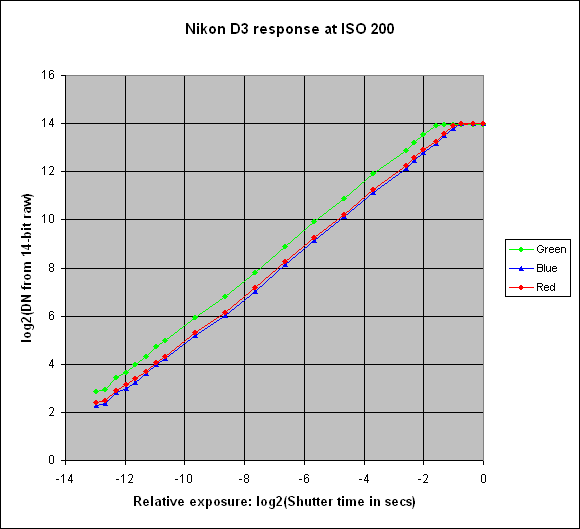The target was a white board lit uniformly. A 70mm lens was used at a distance of 1.5m but focussed at infinity; hence the target was heavily defocused in order to obscure any non-uniformities of the board. The camera was set on manual exposure at f/11. This aperture was chosen because a larger one tends to spread out the signal across the camera's histogram.
A shot was taken at each shutter speed. The shutter speed was varied over a range from 1 second to 1/8000 of a second so as to cover the full range of exposures from off the lefthand end of the camera's histogram to off the righthand end.
The camera was set to write 14-bit raw files and all in-camera noise reduction options were turned off. The raw files were processed in such a way as to extract the numbers (referred to as DN for data number) without any alteration. The raw file was split into its red, green and blue components, but no Bayer interpolation (or 'demosaicing') was done.
The table below shows statistics of a 200 x 200 pixel area in the centre of each image for the green component.
The NEF files in the above table can be downloaded here.
It can be seen that, when heavily overexposed, the green limits at DN=15907. This limit is not imposed by firmware but appears to be caused by saturation of the individual sensor wells: the standard deviation of the DNs falls at that point because Shot noise is reduced by the fact that the wells are overflowing.
At the other extreme, when heavily underexposed, the minimum DN is zero. Unlike Canon, Nikon does not offset the voltage fed into the analogue-to-digital converter, so a DN of zero corresponds to zero illumination and the signal is clipped. Clipping begins five exposures from the bottom of the table and, although the Mean DN continues to fall, its accuracy is compromised by the clipping.
These figures are plotted below:

The white dashed line shows a linear fit to the green curve for the 14 points having shutter times between 0.0004 and 0.3333 seconds (ie. avoiding the extreme ends of the curve). The equation is: DN = 47129 * Shutter Time and R² was 0.9994
The red and blue curves limit at a higher value (16,383) than the green one because these colour components are scaled so that they reach the maximum value that can be accommodated within the 14-bit raw file.
No significance should be attached to the fact that green reaches its maximum value at lower exposures than red and blue. That could be caused by the use of illumination that was not completely white.
On the above graph a lot of points are crowded at the origin. The next graph plots the same figures on logarithmic scales to avoid this:

The response is close to linear over an exposure range of nearly 11 stops. Regarding any departure from linearity, it should be borne in mind that the measurements incorporate also any nonlinearity of the shutter mechanism.
Peter Facey, Winchester, England
20080308 cross ref to data file downloads added
20080122 originated